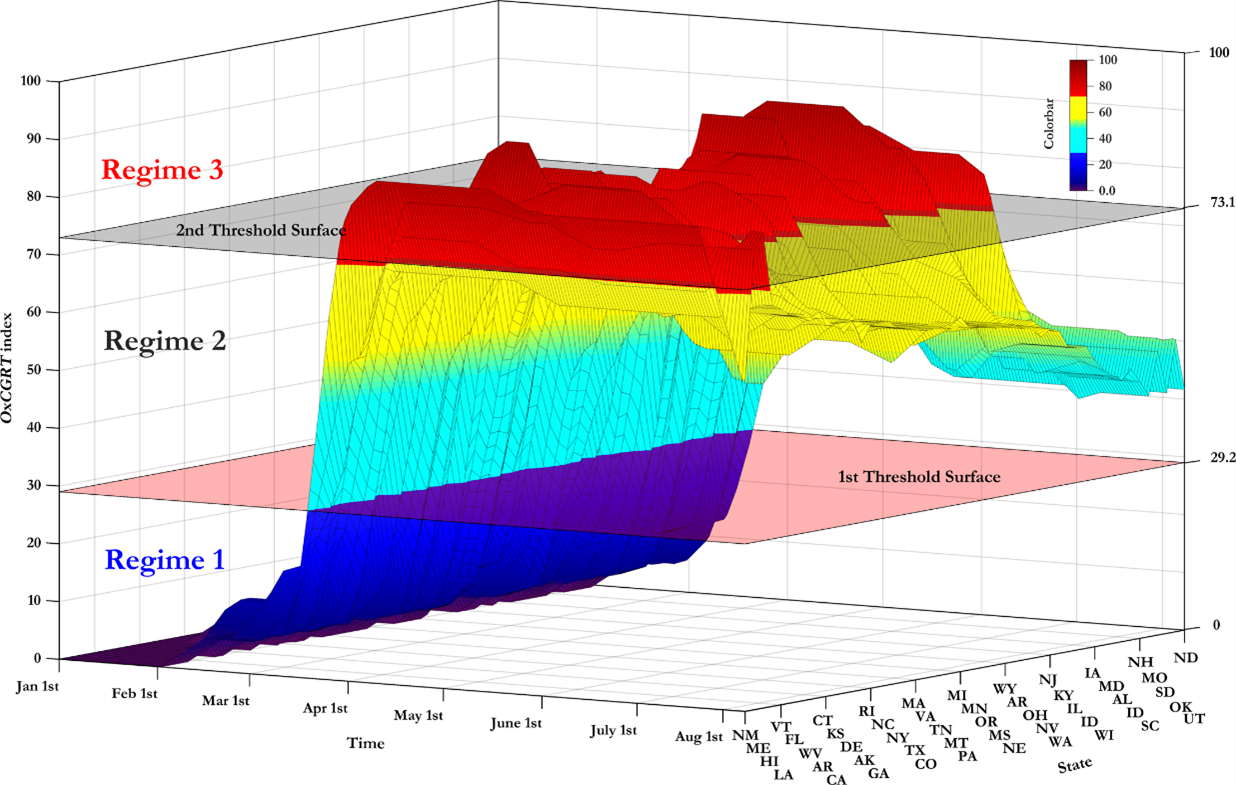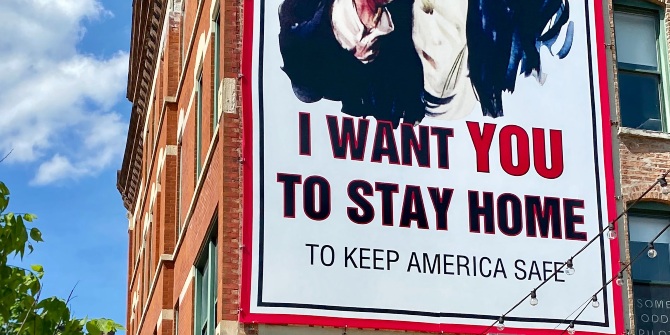


 Before the development of COVID-19 vaccines to reduce the spread of the virus, US state and federal authorities were limited to non-pharmaceutical interventions such as school and workplace closures, the cancelation of public events, and public information campaigns. In new research, Theologos Dergiades, Costas Milas, Elias Mossialos, and Theodore Panagiotidis look at the effects of these interventions in the early days of the pandemic. They find that, in the absence of a vaccine, when used alongside economic support measures, such interventions were effective in controlling the growth of COVID-19 infections.
Before the development of COVID-19 vaccines to reduce the spread of the virus, US state and federal authorities were limited to non-pharmaceutical interventions such as school and workplace closures, the cancelation of public events, and public information campaigns. In new research, Theologos Dergiades, Costas Milas, Elias Mossialos, and Theodore Panagiotidis look at the effects of these interventions in the early days of the pandemic. They find that, in the absence of a vaccine, when used alongside economic support measures, such interventions were effective in controlling the growth of COVID-19 infections.
COVID-19 is continuing to spread globally with more than 551 million infections and 6.34 million deaths. Lessons from previous pandemics reveal that timeliness and stringency are crucial aspects for maximizing the effectiveness of non-pharmaceutical interventions (NPIs) such as mask wearing, contract tracing, social distancing, and bans on public gatherings, and minimizing the adverse social and economic consequences. Using historical data on the timing of 19 different types of NPIs in 17 US cities during the Spanish flu pandemic, academic research shows that implementation of multiple interventions at an early phase of the epidemic reduced peak death rates at a substantial magnitude (~50 percent). But what did these types of interventions mean for the spread of COVID-19, more than a century later?
In new research we quantify the impact of non-pharmaceutical interventions (NPIs), economic support measures (ESM), and their interplay, on the growth of COVID-19 infections. We focus on the US which has been severely hit by the COVID-19 pandemic. With more than 87 million cases and one million deaths, the US has the highest number of confirmed infections and official death toll in the world. In the absence of a centralized federal response, there has been extreme variability in the timing and intensity of interventions in the US states, and even at a county and city-level. Measures started being implemented only after March 10, 2020, 13 days after the first report of community transmission. California was the first state to enact a lockdown, followed by the Midwest and parts of the Northeast, as well as Louisiana. Later adopters were largely concentrated in the Middle Atlantic and upper Midwest. By April 20, 2020, 40 out of the 50 states had adopted state-wide lockdowns. Academic research estimates a decline of up to 43.7 percent in COVID-19 cases three weeks after the implementation of state-wide quarantine, with significant heterogeneity attributed to the timing of the enactment and state-specific characteristics.
Photo by Jennifer Griffin on Unsplash
The effect of government interventions on COVID-19 infections
Our own work extends previous literature in two directions. First, we consider the impact of NPIs on infections depending on whether the stringency is too low, medium, or too strong. Second, we assess the role of the deployed economic support measures (ESM) on COVID-19 infections; an issue that has largely been overlooked. Time-lapse videos illustrating the growth rate of infections per 100,000 inhabitants jointly with the implementation of NPIs, ESM, temperature, and relative humidity, at state level, are available here.

In the presence of ESM, government interventions are likely to become more effective in bringing infection cases down. This is because employees, and the public in general, are more likely than not to stick to government intervention measures when economic support is in place. In addition, the spread of COVID-19 occurs predominantly via respiratory droplets and aerosols. In this case, temperature and relative humidity can affect transmission through virus survival. At lower temperatures, the virus survives longer and, at lower relative humidity, infectious respiratory droplets and aerosols stay suspended in the air for longer.
Using panel-data techniques, we find that the impact of government NPIs on infections growth is significant and varies on the level of severity. We identify three distinct regimes, i.e., regimes of ‘low’, ‘medium’, and ‘high’ severity interventions (see Figure 1 below). A 10 percent increase in the level of the average NPIs (averaged over the previous 14 days) lowers the daily growth rate of infections by 0.35 percent in the ‘low’ regime, by 0.49 percent in the ‘medium’ regime, and by 0.55 percent in the ‘high’ regime.
Figure 1 – NPIs and estimated regimes

Notes: (i) The vertical left-axis depicts the stringency of NPIs (proxied by the OxCGRT index which is bounded between 0 (that is, no interventions) and 100 (that is full lockdown)); the bottom horizontal left-axis displays the date, and the bottom horizontal right-axis depicts the state (identified by the two-digit code abbreviation). The three estimated regimes of stringency (that is, ‘low’ stringency, medium’ stringency, and ‘high’ stringency) range between [0-29.2), [29.2-73.1), and [73.1-100], respectively, based on the values of the OxCGRT index.
(ii) The two-digit state abbreviations are: Alabama: AL, Alaska: AK, Arizona: AZ, Arkansas: AR, California: CA, Colorado: CO, Connecticut: CT, Delaware: DE, Florida: FL, Georgia: GA, Hawaii: HI, Idaho: ID, Illinois: IL, Indiana: IN, Iowa: IA, Kansas: KS, Kentucky: KY, Louisiana: LA, Maine: ME, Maryland: MD, Massachusetts: MA, Michigan: MI, Minnesota: MN, Mississippi: MS, Missouri: MO, Montana: MT, Nebraska: NE, Nevada: NV, New Hampshire: NH, New Jersey: NJ, New Mexico: NM, New York: NY, North Carolina: NC, North Dakota: ND, Ohio: OH, Oklahoma: OK, Oregon: OR, Pennsylvania: PA, Rhode Island: RI, South Carolina: SC, South Dakota: SD, Tennessee: TN, Texas: TX, Utah: UT, Vermont: VT, Virginia: VA, Washington: WA, West Virginia: WV, Wisconsin: WI, Wyoming: WY.
(iii) The first and second thresholds of the OxCGRT index are signified by the pink and grey surface, respectively.
(iv) The surface for the OxCGRT index is coloured based on the range of values assigned to each regime.
We also find that a 10 percent increase in economic support measures lowers the daily growth of infections by 0.06 percent. Therefore, economic help can be viewed as an important factor towards reducing infections since the population will more likely adhere to government intervention measures when economic support is also provided.
In addition, climatic conditions affect the growth of COVID-19 cases. An increase by one degree Celsius in temperature lowers the daily growth of infections by 0.05 percent, whereas a unit increase in relative humidity lowers the daily growth of infections by 0.08 percent.
Finally, the largest impact towards reducing infections comes jointly from school closures, workplace closures, the cancelation of public events, and restrictions on internal movement, followed by the stay-at-home requirements, and the closure of public transport.
The importance of COVID-19 vaccines
What are the implications of our research for the US and worldwide? Based on our results it is tempting to argue that what some have termed ‘draconian’ government interventions might have to be put in place to reduce the growth rate of COVID-19 infections not least because such action will arguably restrict the chances of the virus evolving even further. That said, our results do not consider the rolling out of the vaccination program which took effect from December 2020 onwards. The emergence of mutated COVID-19 variants with higher transmissibility seems to suggest that the success of the vaccination program towards controlling the pandemic will depend, among other things, on how fast the virus mutates, on whether new versions of the approved vaccines can be rolled out in a speedy manner to tackle the variants of the virus, and on vaccine acceptance. In June 2022, vaccine acceptance in the US, for instance, stood at 84.1 percent (this was roughly the same as the vaccine acceptance of 84.43 percent almost a year earlier). All in all, it makes sense to expect that some NPIs measures will remain in place even as the current and future vaccination programs ‘attack’ the pandemic.
- This article is based on the paper, ‘COVID-19 anti-contagion policies and economic support measures in the USA’ in Oxford Economic Papers
Please read our comments policy before commenting.
Note: This article gives the views of the authors, and not the position of USAPP – American Politics and Policy, nor the London School of Economics.
Shortened URL for this post: https://bit.ly/3Op3hVK
About the authors
 Theologos Dergiades – University of Macedonia
Theologos Dergiades – University of Macedonia
Theologos Dergiades is an Assistant Professor of Applied Macrofinance and Information Demand at the Department of International and European Studies at the University of Macedonia. He received his Ph.D. in 2010 from the University of Macedonia in Economics. His research focuses on identifying and analysing statistical trends in order to make sense of economic policies.
 Costas Milas – University of Liverpool
Costas Milas – University of Liverpool
Costas Milas is a Professor of Finance at the University of Liverpool. His research interests focus on Monetary Policy issues. He obtained his M.Sc. and Ph.D. in Economics from the University of Warwick. His research has examined the effects of monetary policies in Britain and in the Eurozone. Most recently, Professor Milas has been particularly interested in analysing the impact of the COVID-19 Pandemic on the American and British economies.
 Elias Mossialos – London School of Economics
Elias Mossialos – London School of Economics
Elias Mossialos is Brian Abel-Smith Professor of Health Policy, Department of Health Policy and Director of LSE Health.
 Theodore Panagiotidis – University of Macedonia
Theodore Panagiotidis – University of Macedonia
Theodore Panagiotidis is a Professor of Econometrics at the Department of Economics at the University of Macedonia. His research interests include Applied Economics and Financial Econometrics. He received his Ph.D. in 2003 in Economics from the University of Sheffield.




